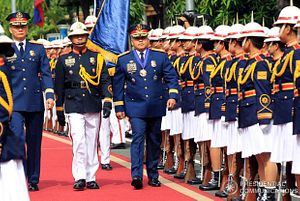This week, the Philippines’ outgoing police chief flew on one of the service’s new helicopters that had been ordered last year right before his retirement. The development put the spotlight on both the growing role of the Southeast Asian state’s police force under President Rodrigo Duterte as well as a capability that has been the subject of controversy in the broader context of the Philippine security.
As I have noted before, though much of the attention on security developments in the Philippines tends to be paid to the military, the recent capability boosts for the Philippine National Police (PNP) under Duterte given its enhanced law enforcement responsibilities, including within the war on drugs, has been notable too (See: “What Will Philippine Military Modernization Under Duterte Look Like in 2018?”). In addition to line items requested as part of the PNP modernization program, including the Capability Enhancement Program (CEP), the PNP has also received significant supplemental funding from the Duterte government as well, leading to some scrutiny from critics about its priorities.
In February, for instance, outgoing PNP chief Ronald dela Rosa noted at a commissioning ceremony at a police facility that the institution had procured a whole range of new equipment, including not just motorcycles, trucks, machine guns, and radio devices, but also some relatively more expensive items such as unmanned aerial vehicles and helicopters. At the time, Dela Rosa disclosed that the funding that was allocated by the government has allowed it to fulfill up to 98 percent of its logistical requirements – a marked contrast from the Southeast Asian state’s recent history of unmet service needs.
Unsurprisingly, of the range of equipment that the PNP has been procuring, much of the attention has been on the purchase of new helicopters. Apart from the recent history of irregularities involving helicopters in the Philippine context dating back to former President Gloria Macapagal Arroyo, there has also been recent scrutiny on helicopter acquisitions following the scrutiny on a separate deal involving the military and Canada (See: “What a Dead Philippines-Canada Military Helicopter Deal Would Mean”).
With respect to the PNP, one Bell helicopter was ordered last June for over 435 million pesos, with Dela Rosa subsequently announcing that more would be in the pipeline for 2018 and 2019 in addition to the two Airbus helicopters expected to come in by the end of the year as well. The Bell order had been progressing into 2018, with PNP personnel in the United States for training early this year as well.
On April 12, one of the Bell helicopters were delivered to the Philippines, about three months ahead of the July 2018 expected delivery date. And on April 16, the helicopter underwent its maiden flight, with Dela Rosa flying in the helicopter to the Philippine Military Academy grounds in Baguio City for a testimonial parade for his retirement.
Speaking at a press briefing, Dela Rosa said the acquisition of the helicopter would greatly strengthen the operational capability of the PNP in addressing a wide range of threats – including criminality, terrorism, and other humanitarian emergencies – that would require support operations that included the provision of air support.
But, as expected, he, like other Philippine officials in recent months, stayed away from disclosing their specific use – whether in terms of combat or counterinsurgency operations – in order to avoid the scrutiny that had been around the AFP’s helicopter deal earlier this year. PNP units have in the past involved themselves in supporting roles in counterinsurgency and maritime operations as well in addition to what some might typically conceive of as traditional law enforcement responsibilities.
Given the PNP’s expanded role and growing capabilities within Philippine security in the Duterte era as well as its changing leadership following Dela Rosa’s retirement, new acquisitions and how they are utilized bear careful watching. And with more helicopters expected to be coming in during 2018 and 2019, that will continue to be a line item that will be in the headlines as well.

































